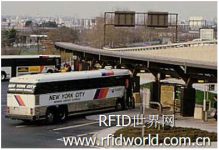
Montreal uses RFID system to dispatch vehicles
[ad_1]
The two newly-built bus and subway transportation terminals in the Laval suburb of Montreal, Canada use RFID systems to notify each car’s entry and exit in real time, so that passengers do not have to wait outside in the cold in winter.
Install an RFID reader on the lamp post at the entrance of the terminal. The reader reads the passive EPC Gen 2 UHF tags on the vehicle, and then sends the ID number of the tag, together with the reading time, to the station On one server. The ID number of each tag corresponds to the route information of its representative vehicle in the database. The server uses RFID data to determine that the vehicle is approaching its designated entry site, and displays this information on the digital display in the station to inform passengers to allow sufficient time to get out of the waiting room and board the vehicle.

Vehicles entering and leaving the stationReal-time notification
Laval residents welcome the application of the system, said Pierre Malboeuf, president of RFID system integrator Eminencia.
The RFID system has also improved the vehicle service and operation of the two terminal stations because it provides staff with visibility of vehicles entering and leaving the site, using a site map on the computer, which shows the event of each vehicle entering or leaving the site.
On an independent computer screen, each dispatcher can monitor the schedule of vehicles in real time. The schedule lists the scheduled arrival and departure times of each vehicle in one day. In the past, unless the driver called to inform, otherwise the dispatcher could not understand the delay of the vehicle. Now with the RFID vehicle monitoring system, dispatchers can dispatch vehicles without waiting for feedback from the driver.
In addition to installing Motorola EPC Gen 2 readers on the lamp posts near the entrance of the station, the station also installs readers beside different lanes. The reader is installed in the center of each lane, equipped with four antennas; there are two on each side of the lane, so that when the vehicle enters the station, the antenna can sense the vehicle tag in time.
The vehicle uses Motorola EPC Gen 2 UHF passive, waterproof Cargo tags, which are pasted on the right window of the vehicle so that when the vehicle enters the station, the tag is closer to the reader antenna. The reading distance of the antenna installed at the entrance and exit of the station is 15 feet, which is the same as the reading distance of the reader antenna installed in the driveway. However, Malboeuf said that the power and directivity of the antennas need to be further optimized so that they can only read the tags of vehicles in the lane they are in, not tags that pass by other lanes nearby.
Vehicle tags can withstand high pressure washing, huge temperature changes (-40-+40) and various harsh natural environments (frost, water mist, etc.).
[ad_2]



